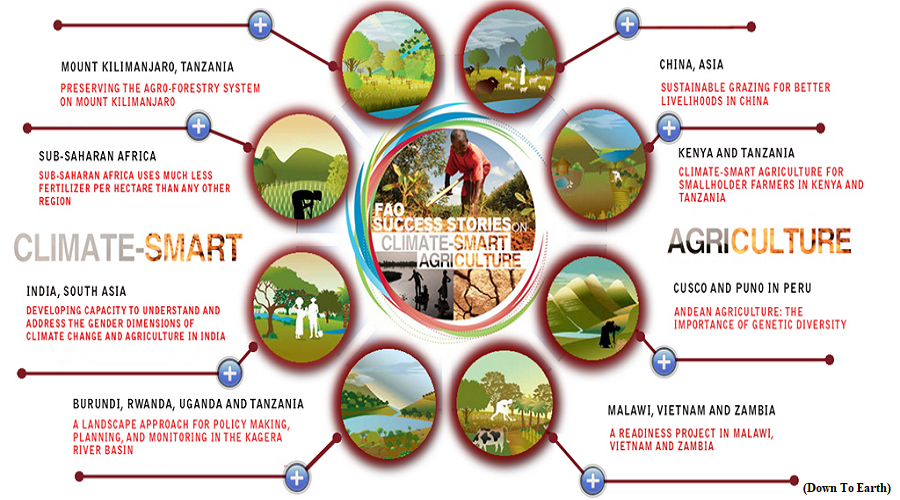Need for climate smart agriculture in India (GS Paper 3, Environment)

Context:
- The two most important issues facing humanity in the 21st century are climate change and food insecurity.
- The need for a holistic strategy is driven by climate change’s dual challenges of adaptation and mitigation, and the pressing need for agricultural production to rise by 60% by 2050 in order to fulfill food demand.
Impacts:
- Some of the ongoing effects of climate change, such as heat waves, flash floods, droughts, and cyclones, are negatively influencing lives and livelihoods.
- The world’s southern continents are reportedly experiencing severe drought due to climate change, which negatively impacts agricultural production and farmers’ livelihoods. Both population expansion and dietary changes are contributing to an increase in the demand for food.
- The effects of the environment on farm output only add to the difficulty. As a result of climate change, traditional farming practices are becoming less productive.
Climate-smart agriculture (CSA):
- As a viable option, climate-smart agriculture (CSA) provides a holistic framework.
- Climate-smart agriculture is an approach for transforming food and agriculture systems to support sustainable development and safeguard food security under climate change.
CSA comprises three pillars or objectives:
- sustainably increase agricultural productivity and incomes;
- adapt and build resilience to climate change; and
- reduce/remove GHG (greenhouse gases) emissions, where possible.
- Dimensions of climate-smart practices include water-smart, weather-smart, energy-smart, and carbon-smart practices. They improve productivity, deal with land degradation, and improve soil health.
Radical reforms:
- The future impacts of climate change on agricultural productivity could be substantial. In India, crop yield decline owing to climate change (between 2010 and 2039) could be as high as 9%. In order to combat climate change and sustainably boost agricultural output and revenue, a radical reform of the agriculture industry is required.
- The United Nations’ Sustainable Development Goals aim to end hunger and enhance environmental management; CSA’s foundation is in achieving these goals through sustainable agriculture and rural development.
- The National Action Plan on Climate Change emphasises the role of climate-resilient agriculture in India’s adaptation measures. Programmes such as the Soil Health Card Scheme use precision nutrient management to optimise agricultural methods.
- The concept of precision farming is still somewhat novel in India. While certain private companies offer services, the scope of these initiatives is extremely limited.
Community-supported efforts:
- CSA’s value in minimising and adjusting to the effects of climate change on agriculture is becoming widely acknowledged on a global scale. There has been a worldwide uptick in community-supported agriculture efforts. These efforts are made in an attempt to create agricultural systems that are both resilient and environmentally friendly.
- Improvements in agroforestry, sustainable water management, and precision agriculture are all concrete examples of CSA ideas in action, and they are not limited by any one country.
- CSA promotes crop diversification, increases water efficiency, and integrates drought-resistant crop types, all of which help lessen the disruptive effects of climate change.
- The importance of CSA lies in its ability to increase agricultural output while maintaining ecological stability. This correlation is not only a desired consequence but rather essential for long-term food security and sustainable resource usage in a warming planet.
- By reducing exposure to climate-related dangers and shocks, CSA increases resilience in the face of longer-term stressors like shorter seasons and erratic weather patterns.
Economic autonomy:
- CSA causes a dramatic change in farming communities’ economic and social structure by distributing information about and providing access to climate-resilient methods.
- As the climate changes, farmers, significantly those already disadvantaged, can gain enormously from adopting climate-smart techniques. The increasing popularity of CSA is a promising indicator for the future of biodiversity conservation.
- CSA’s ecosystem-based approach and different crop varieties help cropland and wild regions coexist together. This collaborative effort helps to safeguard native plant species, keep pollinator populations stable, and mitigate the effects of habitat degradation.
Mitigation:
- The agricultural sector also produces a large amount of GHGs. The sector’s share in GHG’s emissions in 2018 was 17%. Therefore, CSA implementation is crucial for lowering GHG emissions and protecting biodiversity.
- It aids in enhancing farmland carbon storage. The Paris Agreement goal of limiting global warming by reducing GHG emissions is tied directly to the success of the CSA.
- Agroforestry and carbon sequestration are two examples of CSA measures that could help India meet its international obligations and contribute to the global fight against climate change.
Challenges:
- Rather than being a rigid set of rules, CSA is more of a flexible concept with a wide range of potential applications.
- However, the most challenging aspect of dealing with global warming is to create localised responses. Therefore, investing in capacity-building programmes and providing practical CSA tools and knowledge is essential.
India’s response:
- The majority of Indian farmers are small or marginal. Therefore, CSA can play a significant role in helping them increase their profits.
- The intersection of climate vulnerability and agricultural importance places India at a unique juncture where CSA adoption is not merely desirable but essential.
- The National Adaptation Fund for Climate Change, National Innovation on Climate Resilient Agriculture, Soil Health Mission, Pradhan Mantri Krishi Sinchayee Yojana, Paramparagat Krishi Vikas Yojana, Biotech-KISAN, and Climate Smart Village are a few examples of government initiatives in India focusing on CSA.
- Various public and private sector entities such as farmer-producer organisations and NGOs are also working towards the adoption of CSA.
Way Forward:
- CSA has the potential to assure food security, empower farmers, and protect our delicate ecosystems by merging innovation, resilience, and sustainability.
- In the face of a changing climate, the path of CSA stands out as a source of inspiration and transformation for a world working to ensure a sustainable future.


